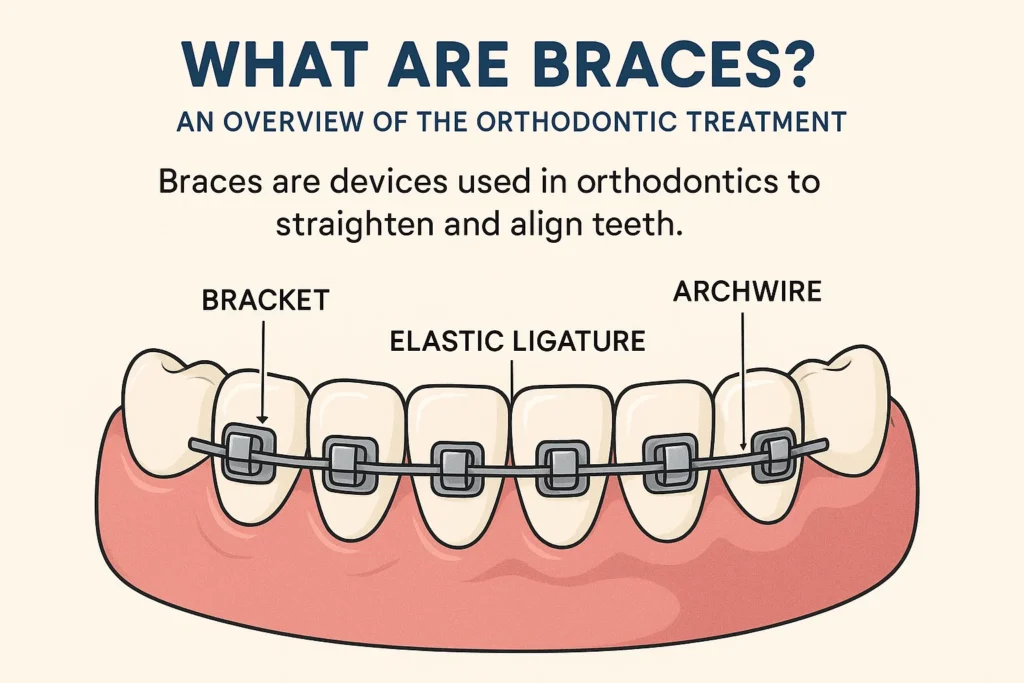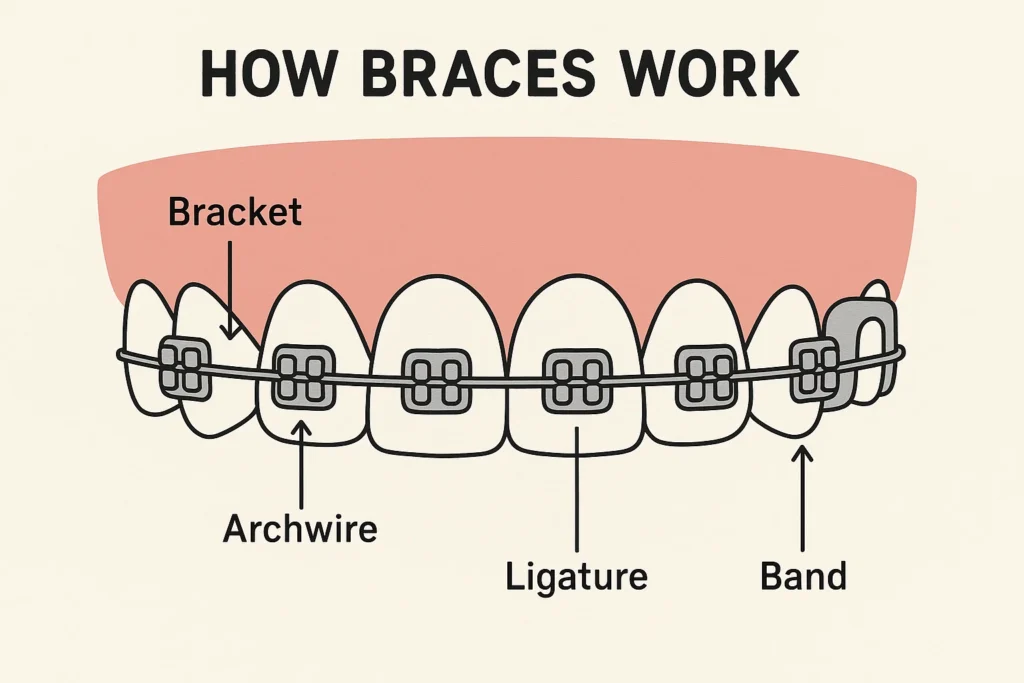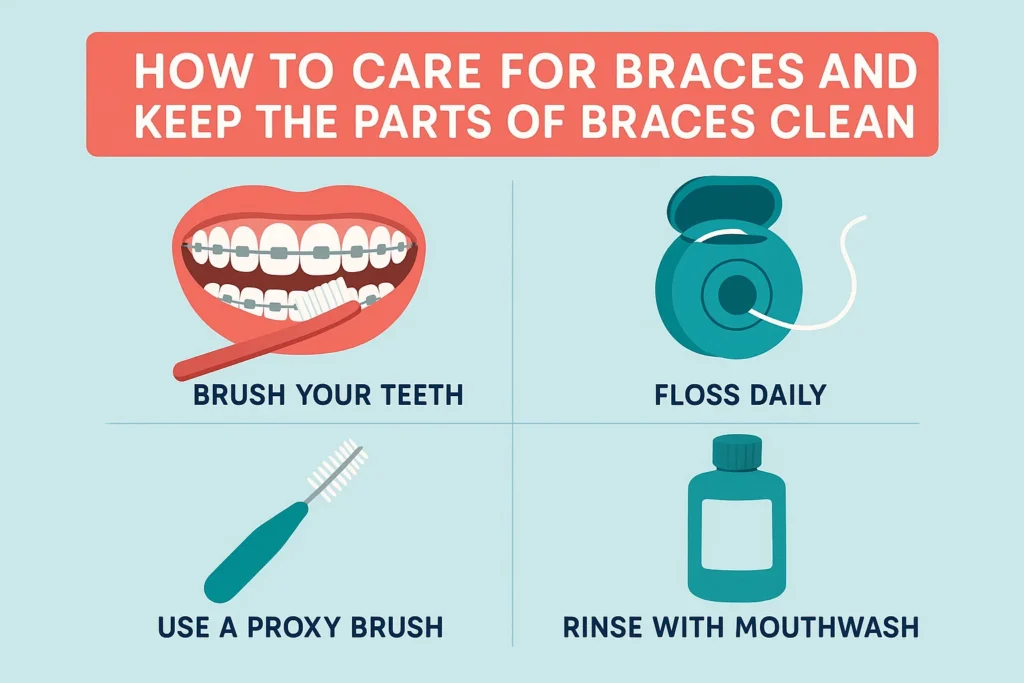Parts of Braces: Understanding the Key Components of Your Orthodontic Treatment

Parts of Braces: A Complete Guide to Understanding the Components of Your Orthodontic Treatment
Introduction
Getting braces is not as simple as just placing brackets on your teeth; there is your treatment plan and numerous parts that work in unison. Parts of braces work together flawlessly and each of them has a job that interacts with the other parts for the best results. For a novice, knowing the role each part of braces play will definitely help in grasping the entire process seamlessly and will certainly make it less frightening.
This guide is tailored to help you grasp the fundamentals of braces and will be useful to you whether this is your first time getting them, or you are just inquisitive. I’ll cover each piece of a brace, including the brackets and archwires, their individual roles, and their overall significance.
1. What Are Braces? An Overview of the Orthodontic Treatment

Braces are an orthodontic appliance which is used for managing teeth alignment, for correcting occlusal problems, and enhancing oral health. They function by moving teeth into alignment over time using different components of braces.
While the primary purpose of braces is to enhance the smile, they also significantly aid in the correction of orthodontic problems like overbite, underbite and crossbite. Balancing the alignment of braces improves smile and also enhances its bite functionality.
2. Main Parts of Braces
Braces are made up of several components, each playing a unique role in the treatment process. Here’s a breakdown of the main parts of braces:
1. Brackets
Brackets are small squares or rectangles which are attached to the surface of teeth. They are the most noticeable component of the braces and are commonly constructed from metal, ceramic, or plastic.
Role of Brackets:
Attachment: Brackets are bonded directly to the surface of each tooth using a special adhesive.
Wire Connection:Through the brackets, the archwire passes, and in this way, the brackets serve as anchors as well.
Types of Brackets:
Metal Brackets:These are the most usual types which also have the longest endurance. They are constructed of stainless steel and are very useful for most orthodontic procedures.
Ceramic Brackets:They are popular among adults because they are tooth-colored which makes them blend in with your natural teeth more seamlessly as compared to other methods.
Self-Ligating Brackets:These are a modern type of brackets which do not use elastic ligatures to hold the archwire. A small clip that secures the wire reduces friction.
2. Archwire
The arch wire is the delicate piece of wire that stretches across the brackets of your braces. This wire serves the important function of applying the necessary pressure to the teeth to facilitate movement towards desired positions.
Role of Archwire:
Movement: The archwire transfers pressure from the brackets to the teeth, guiding them into proper alignment.
Adjustments: Over time, the archwire is adjusted to provide the right amount of pressure needed for tooth movement.
As with other components of the orthodontic apparatus, the archwire is made of either stainless steel or nickel-titanium which can be more pliable and useful for some movements of the teeth.
3. Ligatures
Ligatures are the elastic bands or metal ties that secure the archwire to the brackets. They are typically changed at each orthodontic appointment.
Role of Ligatures:
Securing the Archwire: Ligatures hold the archwire firmly in place within the brackets.
Color Customization:Creating smiles and boosting confidence is a huge part of what orthodontists do and many orthodontists will now allow patients to choose colors for their ligatures. With so many colors to choose from, this part of braces treatment can be both fun and customizable.
Ligatures may be classified as elastic or metal. While elastic ligatures are colorful, metal ligatures are used with self-ligating braces which have brackets that clip shut to hold the wire.
4. Bands
Bands are thin strips of stainless steel or titanium that encircle the back of the molars. They are cemented to the molars and serve to fasten multiple parts of the braces including the archwire.
Role of Bands:
Anchoring the Braces: Bands help secure the braces to the back teeth and provide a strong foundation for the entire treatment.
Attachment Points for Other Components: Bands may also have hooks for elastics or springs that provide additional tooth movement.
Not all patients require bands, but they are commonly used for complex cases or when extra support is needed for molar teeth.
3. Additional Parts of Braces
In addition to the main components, there are several additional parts of braces that help enhance the effectiveness of the treatment:
1. Springs
Springs can be connected either to the archwire or the brackets to give extra force. They are available in different types and sizes which depends on the movement desired for the teeth.
Role of Springs:
Space Creation: Springs help create space between teeth if they are crowded.
Tooth Shifting: They can also be used to push or pull specific teeth into position.
2. Elastics (Rubber Bands)
Elastics are basically rubber bands that are fastened to brackets or hooks on bands to assist in aligning the bite. Depending on your specific plan, they can be applied full-time, part-time, or only during specific intervals throughout the day. They are available in different sizes and strengths.
Role of Elastics:
Bite Adjustment: Elastics help correct issues like overbite or underbite by moving the upper and lower jaws into alignment.
Tooth Movement: They can also assist in shifting teeth into the desired positions more quickly.
3. Power Chains
A power chain functions as an elastic chain which patients wear over their brackets to bridge tooth gaps. The power chain delivers uniform pressure to teeth because it functions differently from individual ligatures which move teeth together.
Role of Power Chains:
Closing Gaps: Power chains help close spaces or gaps between teeth, speeding up the treatment process.
Constant Pressure: They offer consistent pressure on the teeth, guiding them into alignment.
4. How Do These Parts of Braces Work Together?

All the parts of braces work in unison to gradually move your teeth into the correct positions. Here’s how they function as a system:
Brackets act as anchors, attaching each tooth to the braces.
The archwire connects the brackets, providing a pathway through which pressure is applied.
Ligatures secure the archwire to the brackets, providing tension and pressure that guide teeth movement.
Bands support the back molars, keeping them stable and ensuring the braces are firmly attached.
Springs create extra force to help shift specific teeth or make space for movement.
Elastics provide additional pressure to correct bite alignment issues.
Power chains help close gaps between teeth, allowing for smoother alignment.
Each part of the braces plays a critical role in ensuring your teeth move into their desired positions in a timely and efficient manner.
5. How Long Does It Take for Braces to Work?
The duration of braces treatment depends on the extent of alignment problems and the type of braces and the patient’s age. The duration of braces treatment ranges from 12 months to 36 months.
Mild cases: May require 6–12 months.
Moderate cases: Could take 12–18 months.
Severe cases: May take 18–36 months.
Adjustments to the braces, such as changing archwires or ligatures, are made regularly to ensure continuous progress throughout the treatment process.
6. What to Expect When Getting Braces
Your orthodontist will attach the brackets to your teeth through a particular adhesive when you receive your first braces. The orthodontist will place the archwire followed by ligatures to maintain its position. The teeth shifting process will cause you to feel discomfort after the procedure.
Your orthodontist will schedule regular appointments which include adjustments and ligature or power chain replacements and progress monitoring every 4–6 weeks.
7. How to Care for Braces and Keep the Parts of Braces Clean

Caring for your braces is crucial to ensure that all the parts of braces function effectively. Here’s how to maintain them:
Brush after every meal using a soft-bristled toothbrush to remove food debris from brackets and wires.
Floss with a special orthodontic flosser to clean between teeth and brackets.
Use mouthwash with fluoride to help prevent cavities and gum disease.
Avoid sticky or hard foods that can damage brackets or wires.
8. Common Issues with Parts of Braces and How to Fix Them
Braces may sometimes experience issues, such as loose brackets, broken wires, or discomfort. Here’s what to do:
Loose bracket: Call your orthodontist to have it replaced. In the meantime, use orthodontic wax to prevent irritation.
Broken wire: Use wax to cover the sharp end, or clip it carefully with sterilized scissors.
Discomfort: If the wires are poking into your gums or cheeks, apply orthodontic wax to cushion the area.
9. How Molar Removal Affects Braces Treatment Time
The removal of molars becomes necessary for braces treatment to establish space for other teeth. The removal of molars at first appears negative but it actually accelerates your treatment by making space for teeth to achieve their correct positions.
10. Cost of Braces Treatment
The cost of braces can vary significantly depending on factors such as the complexity of your case, the type of braces, and your location.
Traditional metal braces: $3,000 to $7,500
Ceramic braces: $4,000 to $8,000
Clear aligners (Invisalign): $3,000 to $8,000
Your orthodontist will provide a more specific cost estimate after evaluating your individual treatment needs.
11. Alternatives to Traditional Braces
Traditional braces work well but patients have two alternative options which include clear aligners (Invisalign) and ceramic braces that offer better aesthetics and improved comfort. If traditional braces do not suit you then ask your orthodontist about the most suitable alternative.
12. Final Thoughts: Understanding the Parts of Braces
The proper understanding of brace components and their operational mechanisms enables you to maximize your orthodontic treatment results. The brackets along with archwire and ligatures function together as essential components to properly align teeth and fix bite problems.
Your orthodontic treatment will succeed when you follow your orthodontist’s guidance and practice proper oral care and schedule regular check-ups to obtain your desired beautiful healthy smile.
Pros and Cons of Braces: How to Decide If Braces Are Right for You



